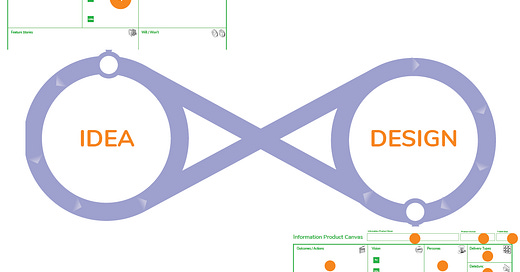Craft your own WoW
One data team adapted the way they completed the canvas to tackle the challenges of a greenfield environment
The Information Product Canvas is an open-source template designed for change. You adapt and iterate it to suit your data team and your organisation’s specific context. Everything in this substack reflects the way I work with the canvas, think of it as a set of patterns you can use to shape and refine your own Way of Working. It’s not a rigid framework or methodology to be followed step by step.
One data team adapted the way they completed the canvas to tackle the challenges of a greenfield environment, where there were no existing Information Products or clear stakeholder expectations already in place. They faced too many unknowns and needed a way to define and scope potential Information Products without spending too much time gathering requirements and too little delivering value to their stakeholders. At the same time, they wanted to avoid an ad-hoc approach that would lead to inconsistent priorities, duplicated effort, and a lack of strategic direction.
They knew if they completed all 12 areas of the canvas for every potential Information Product, they would end up with hundreds, many of which would never be designed, built, or deployed within the first 12 months. Yet they still needed to uncover all potential Information Products to understand the long-term 3–5 year roadmap and prioritise their focus for the first year.
To balance these needs and avoid wasted effort, they crafted their own Way of Working that allowed them to move quickly while still maintaining flexibility as new insights emerged. The data team ran Information Product Canvas workshops with stakeholders but only filled out four key areas, Outcomes & Action, Personas, Product Owner and Vision Statement.
Once these initial 4 areas were completed, they grouped all the Information Product Canvases based on business process domains, as well as by outcomes and use cases.
These high-level groupings played a critical role in the prioritisation process, helping the team identify which Information Products to design, build and deploy first. Once they had a prioritised list of Information Products, they completed all 12 areas of the Information Product Canvas during the Design step.





This makes a lot of sense. First, you gather all the use cases, and then only drill down with the canvas where you decide to prioritize higher. I ran many product canvas and metrics canvas workshops in the past and I find it to be similar.
I'd also like to invite you to my Substack "Signal to Product" where I talk about decision intelligence products. Seems like we have some things in common: signaltoproduct.substack.com
Interesting idea 💡 - when we worked through some examples, the vision statement was alwaysntheadt bit and was the culmination of all the sections, interested to know how they approached that instead. I think doing a lightweight version up front to help drive priorities makes a lot of sense